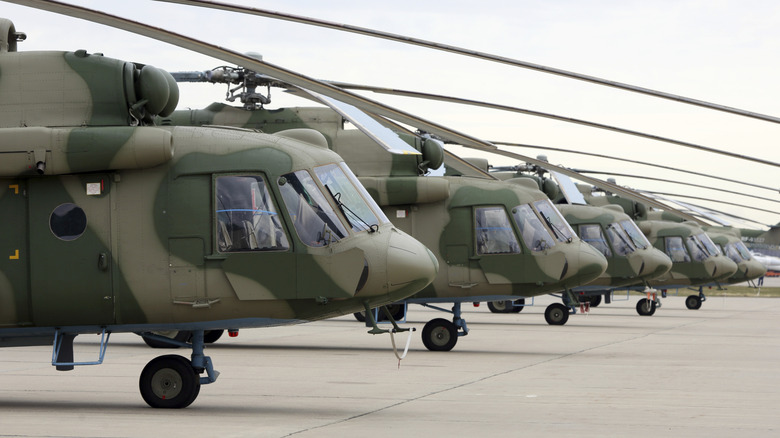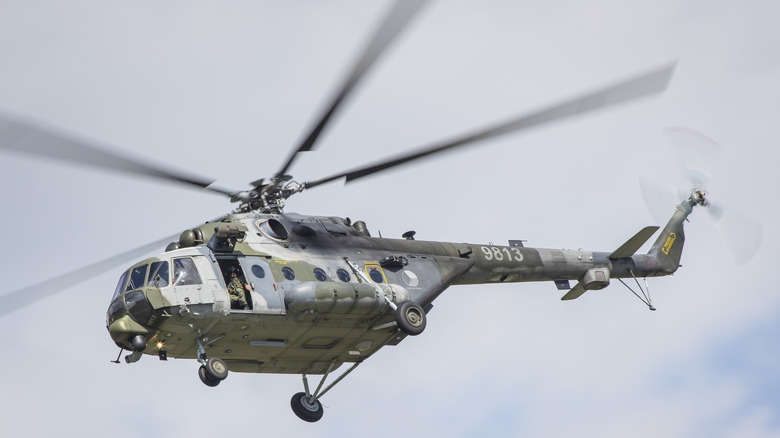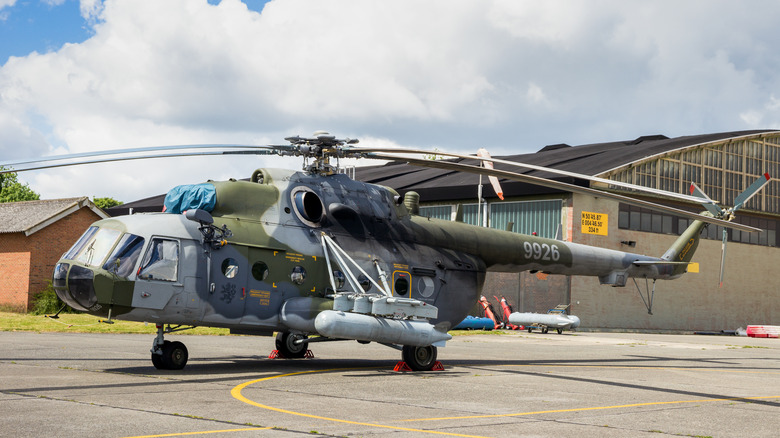What Is The Most Produced Helicopter In The World? The Answer Might Surprise You
Helicopters are incredibly versatile aircraft that can fulfil innumerable civilian and military roles. On September 14, 1939, the world's first practical helicopter flew for the first time, with Igor Sikorsky behind the controls of his self-designed VS-300. Although the invention of the helicopter arrived too late to have any meaningful impact during World War II, some little-known helicopters were used in the conflict. Sikorsky went on to found Sikorsky Aircraft, and ultimately the company built — among others — the Black Hawk helicopter, of which there were 5,000 made for 36 nations. However, as impressive as these figures are, they don't come close to matching the total of the most produced helicopter in the world. Even the Bell UH-1 Huey isn't in the mix, with an impressive 16,000 built.
To find the most produced helicopter in the world, we have to visit Sikorsky's homeland — Russia (Sikorsky was born in Kiev in 1889, which was then part of the Russian empire). More specifically, we need to look at the Mil Mi-8 helicopter, which first took to the air in 1961 and remains in production today, more than 60 years later. In total, over 17,000 of these helicopters have been built and are in service in around 80 countries.
The Mi-8 transport helicopter - a versatile workhorse
It's a quirk of history that the most widely manufactured helicopter in the world was inspired by a design from a man who'd switched allegiance from Russia to America. Yet, the inspiration for the Mi-8 is believed to have come from Nikita Khrushchev's state visit to America in 1959. During this visit, he was transported in the Sikorsky S-58 presidential helicopter. Impressed by what he saw, he decided the Soviet Union needed a similar vehicle. The challenge of producing such a beast fell to Mikhail Mil. Full production of the Mi-8 began in 1964, and initially, it received a lukewarm welcome from the Soviet Military. However, they quickly sat up and took notice when they saw the roles helicopters like the army workhorse "Huey" were fulfilling in Vietnam.
The Mi-8 has a fuselage length of 60 feet and is powered by two TV2-117 turbine engines, producing 1,482 hp each. This gives it the capacity and power to carry a total of 24 to 32 people, depending on the variant, and cargo loads of up to three tons. The helicopter is currently manufactured by Russian Helicopters, which is part of the State Corporation Rostec. The Mi-8 and its Mi-17 variant are produced at two plants – the JSC Kazan Helicopter Plant and the Ulan-Ude Aviation Plant. There have been numerous variants of the helicopter, including the aforementioned Mi-17, which boasts various improvements, including a higher altitude ceiling, improved hot-weather performance, and more powerful TV3-117MT or TV3-117VM turboshaft engines.
Mi-8 - A distinguished if somewhat controversial history
We previously mentioned the versatility of helicopters; the Mi-8 is a living testament to this. It has been used to fulfil innumerable roles in a career that has seen action in countries around the world, including Iran, India, Poland, Ukraine, and even the US. To get a true picture of just how versatile this helicopter has proved to be, we can look at a few of the more common variants. Starting with the Mi-8T, a military/civilian version of the helicopter that can carry up to 24 passengers. For a more luxurious journey, the Mi-8S "Salon" version is a VIP helicopter that seats up to eleven passengers and features a galley and a toilet. Other notable variants include the Mi-8MT flying crane, the polar exploring Mi-8MA, and the Mi-8TZ fuel tanker, to name a few.
Over its long service, a few moments stand out, including the aftermath of the Chernobyl accident, where Mi-8s were used to drop sand, boric acid, and lead onto the burning reactor, during which the crash of an Mi-8 helicopter involved in the operation was captured on film. Decades later, the helicopter is still on the frontlines. It has been widely used in various roles by both sides in the ongoing Russia/Ukraine war. Today, even as sanctions target the manufacturer, the Mi-8 remains a helicopter with unmatched production numbers and a legacy that refuses to fade.


